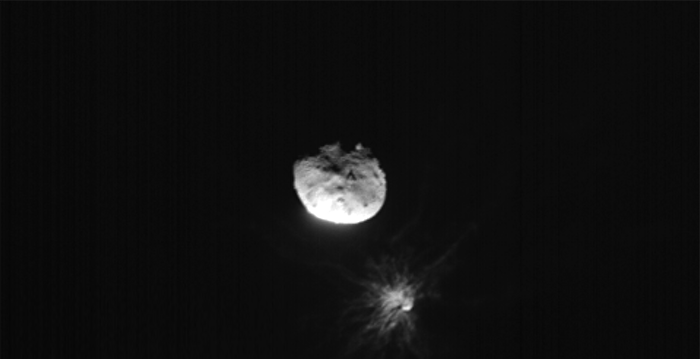[Epoch Times, October 14, 2022](Epoch Times reporter Li Yan comprehensive report) NASA announced on Tuesday (October 11) that its “Double Asteroid Redirection Test” (Double Asteroid Redirection Test) The Redirection Test, DART) mission successfully redirected the orbit of an asteroid millions of miles away.
This is the first time that humans have purposefully changed the motion of a celestial body, and it is also the first time that asteroid deflection technology has been fully demonstrated. After the DART spacecraft slammed into the asteroid Dimorphos, scientists found in a two-week follow-up analysis that the kinetic impact caused the asteroid to orbit its parent planet Didymos. ) orbital time was reduced by 32 minutes.
Prior to this, the 170-meter-diameter Deimos orbited the 780-meter-diameter Didymos for 11 hours and 55 minutes.
The uncertainty margin for this measurement is about plus or minus two minutes.
Astronomers use telescopes—including the Hubble Space Telescope—to measure how much its cycle time varies. The minimum requirement for a successful DART mission, according to NASA’s metrics, is a 73-second change in the orbital period of the target asteroid Deimos.
NASA Administrator Bill Nelson called it a “watershed moment for the planetary defense mission.” “We all have a responsibility to protect our planet, which is our only home after all… This mission shows that NASA is working hard to prepare for whatever the universe throws at us,” he said.
Neither Deimos nor Didymus pose any danger to Earth following a controlled collision of DART with Deimos.
Lori Glaze, director of NASA’s Planetary Science Division, said the current observations are an important step in understanding the impact of the DART spacecraft impact. With the new data, astronomers can better assess how similar techniques can deflect an asteroid’s orbit to protect Earth from its impact.
NASA said the focus now is to turn to measuring the efficiency of momentum transfer during DART’s roughly 14,000-mile-per-hour impact, including further analysis of the impact “ejectors.”
The DART spacecraft launched last year. It was built and operated by the Johns Hopkins University Applied Physics Laboratory (APL) and managed the mission by NASA’s Planetary Defense Coordination Office.
Responsible editor: Li Yuan#
